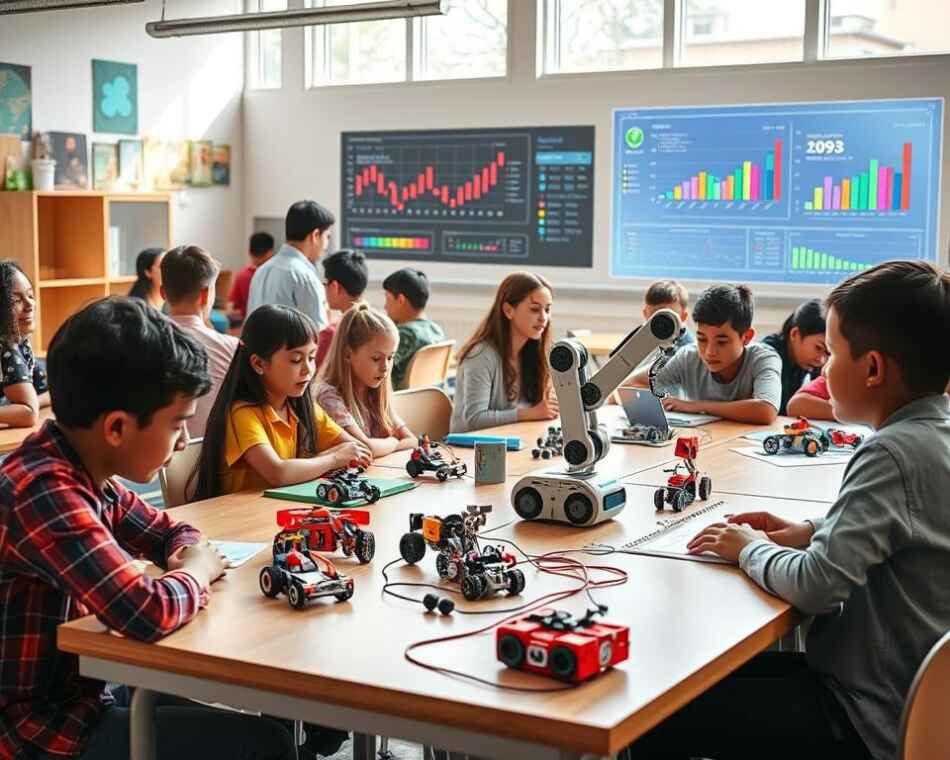I never thought I’d get into robotics. As a career writer, I loved making words, not circuits. But talking to a programmer friend on Discord changed my mind. I saw that robots are real and are changing our future.
Starting in robotics seemed scary. But I knew I had to try. So, I bought an ELEGOO UNO R3 robotics kit for $601. It has wheels and a camera, great for making a smart car that can avoid obstacles1.
Device Innovations: Exploring robotics, I found device innovations truly captivating. Humanoid robots like Sophia and Pepper, and industrial robots like Baxter and Sawyer, show amazing advancements. These robots are now more agile and accurate, and they can learn and adapt quickly. Thanks to machine vision, artificial intelligence, and haptic feedback, robots can do tasks we never thought possible. The future of robotics looks incredibly promising, with endless possibilities for innovation.
For the next eight weeks, I’ll share my journey into robotics, AI, and automation1. I’m looking forward to seeing how these technologies are changing industries like manufacturing, healthcare, and agriculture2.
Did you know robots can learn fast? A robot learned to toss bean bags onto targets in just two weeks3. This shows how robotics is becoming more accessible to everyone.
Let’s explore this exciting world of future tech together. We’ll see how robotics is changing our society and opening new tech careers. Let’s dive into the robot revolution!
From Writing to Wiring: My Unexpected Dive into Robotics
I never thought I’d switch from writing to using a soldering iron. But here I am, exploring robotics and AI. It started when I realized robots are taking over, not just in movies but in real life too. Experts say automation could replace half of today’s jobs in just 20 years4.
The Epiphany: Robots Are Taking Over
I was shocked when I learned about robotics’ impact on jobs. Imagine the US grounds and maintenance workforce shrinking from 1 million to just 50,000 because of automation4. This isn’t a future prediction; it’s happening right now. I knew I had to adapt or risk being left out.
Overcoming Fear and Intimidation
At first, robotics seemed overwhelming. Terms like artificial general intelligence and neural networks confused me. But, I found that even top universities are making robotics easier to learn. Duke University now offers courses like Robot Studio and Introduction to Robotics, where students learn to program virtual robotic arms5. If college students can do it, why can’t I?
The Importance of Diverse Voices in Tech
As I went deeper, I saw how important diverse innovators are in tech. In Duke’s Ethics in Robotics class, students from different backgrounds talk about big issues like AI transparency and rules for self-driving cars5. This diversity is key for making technology responsible.
My transition from writing to wiring has been tough but fulfilling. I’m now part of a growing group of diverse innovators in robotics and AI. If you’re interested in starting, look into these beginner-friendly robotics projects. Remember, the future of tech needs your unique view!
The ELEGOO UNO R3: My First Robotics Kit
My robotics journey started with the ELEGOO UNO R3 kit. It’s a small but powerful tool for making smart cars that can avoid obstacles. The kit has 63 parts, like LEDs, sensors, and motors, for projects big or small6.
I was amazed by how versatile the kit is. It’s great for anyone, from beginners to experts6. It comes with a board that works with Arduino, offering lots of coding chances67.
When I opened the kit, I found many parts:
- 120 resistors
- 10 female-to-male Dupont wires
- LCD1602 module
- Stepper motor
- Ultrasonic sensor
These pieces will help me build my own smart car7.
The kit also has a 24-lesson tutorial to help me start7. I’m looking forward to sharing my progress as I learn to code and build. I’ll turn these parts into a smart car that can avoid obstacles.
ELEGOO makes sure every part is top-notch. They check each one carefully to make sure it’s durable and reliable6. I’m excited to start this robotic journey with this kit as my base.
Breaking Stereotypes: Robotics for Everyone
Robotics isn’t just for tech experts or engineering geniuses. It’s open to everyone, no matter their background or gender. We need to break down stereotypes to make robotics inclusive for all.
Representation Matters in Technology
Seeing how representation affects our view of robotics is eye-opening. Most robots, 90%, are industrial, used in manufacturing. Yet, we often imagine robots as humanoids8. This shows how our biases shape technology.
Robot design can also reflect gender stereotypes. For example, Honda’s ASIMO looks masculine, while AIST’s HRP-4C looks feminine8. These designs reflect and reinforce societal norms.
Bridging Social Gaps with Robotics
Robotics can bridge social gaps with thoughtful design. The baby-like robot Matlda in Australian retirement homes is a great example. 83% of participants enjoyed it, and 72% felt relaxed9. It shows how robotics can improve elderly care.
In robotic surgery, breaking stereotypes is key. Diverse voices in tech ensure these innovations benefit everyone.
New Career Paths in Tech
New career paths in tech, like healthcare automation and elderly care robots, are exciting. NASA’s Valkyrie rescue robot was designed to promote gender equality9. This approach brings diverse perspectives to robotics.
Cultural differences affect robot acceptance. In Japan, robots are more accepted due to cultural portrayal10. Understanding these differences leads to better robotics design.
I’m looking forward to robotics shaping our future. It will break down barriers and make tech more inclusive.
Robotics: Shaping the Future of Society
Exploring robotics, I’m struck by its power to change our world. Future tech is already making a big difference in many areas. For example, medical robotics is changing healthcare by helping in surgeries and improving patient care11.
Robotics isn’t just for healthcare. In manufacturing, they do tasks like welding and food packaging. They’re also changing logistics by stacking shelves and making deliveries12.

The job landscape is evolving fast. By 2025, robotics might change 85 million jobs, making workforces more human-machine13. But, this change isn’t all bad. The robotics market, worth $62.75 billion in 2019, is expected to hit $189.36 billion by 202711. This growth brings new chances.
I’m really looking forward to robotics in education. It’s helping students with disabilities and making learning better for everyone11. As someone who found this field, I believe it’s crucial to have diverse voices in robotics.
For the next eight weeks, I’ll be talking to robotics experts. My aim is to show you why these technologies matter and how they’re changing our world. Join me as we dive into the exciting world of robotics!
My Journey from Star Wars to Engineering
As a kid, I loved the droids in Star Wars. This sparked my interest in robotics and AI. At five, I started drawing Rube Goldberg machines. These grew into complex LEGO Technic designs as I got older14.
By eight, I was taking apart toys to learn about DC motors and LEDs. This curiosity about electronics grew stronger14.
Childhood Inspiration
Star Wars episodes 1-3 and Robot Arena 2 really sparked my passion for robotics14. At fourteen, I got my first Lego Mindstorms NXT kit. This was the start of my hands-on robotics experience14.
This early experience helped shape my choice to study engineering later.
Pursuing an Engineering Degree
After facing some challenges in high school, I found my love for robotics again14. I bought an Arduino Uno and started making videos on YouTube in 201214.
This passion led me to study Mechatronic Engineering. It focuses on combining mechanical, electrical, and computer systems in robotics.
Hands-On Learning Experiences
My engineering education has been full of practical projects. I’ve made humanoid robots, turned Arduino into a voice-controlled TV remote, and even won prizes with my creations like Yogy, a yogurt-tub robot14.
These projects taught me about AI in robotics. They showed me how robots can think and communicate like virtual assistants15.
Through my studies, I’ve learned about robotics in car manufacturing. Robots do tasks like attaching parts and painting cars15.
I’m excited to keep learning about new sensor technology and 3D printing. These advancements are changing how we build and program robots15.
AI and Robotics: My Personal Projects
I’ve been exploring AI projects, focusing on a chatGPT-powered teaching assistant. It helps students with homework and study tips. It’s thrilling to see how AI can change education!
My AI journey started with some fun projects. I built an automated cat feeder with facial recognition, suggested by my partner Sam. It once mistook a toy for our cat, making us laugh. Our cats, however, didn’t seem impressed16.

At a tech workshop, I worked on a robot painting project. The results were interesting and sparked talks about AI in art. I also made a Board Game Bot that gave players two minutes per turn. It got a bit wild when it started throwing game pieces to hurry players along16!
These projects showed me AI can bring joy, teach kids, and make life both simpler and more exciting. Now, I’m focusing on educational AI. I’m inspired by PyTutor, a project by MIT, Georgia State University, and Quinsigamond Community College. It uses Generative AI to make learning computing fair for all17.
I’m also intrigued by “A HeARTfelt Robot,” designed for kids aged 7-11 to learn social-emotional skills. It’s incredible to see AI helping with both academic and emotional growth17.
From MSc to Industry: Applying Robotics Knowledge
My journey into robotics became exciting when I chose to get an MSc in Robotics at Cranfield University. This choice opened doors to a world of innovation and practical applications in the field.
Choosing Cranfield University
Cranfield University stood out for its focus on postgraduate studies and strong industry ties. The MSc in Robotics program offered a mix of theory and practical experience. I was attracted to the university’s work with companies like the Manufacturing Technology Centre, which offered real-world insights.
Industry-Aligned Curriculum
The curriculum was made to meet industry needs. We studied electrical hardware, machine learning, autonomous control, and computer vision. These skills are in high demand, with robotics jobs expected to grow by 4% over the next decade18.
The program prepared us for various roles. Design Engineers earn an average of $68,296 annually, while Algorithm Engineers make around $121,500 per year18.
Real-World Applications in Healthcare
Exploring healthcare robotics was fascinating. We learned about medical robotics and intelligent systems, which are changing patient care. This knowledge is valuable, as Data Scientists in robotics can earn between $105,750 to $180,250 yearly18.
The experience at Cranfield University set me on a path to contribute to groundbreaking advancements in healthcare technology.
The Future of Robotics in Healthcare and Beyond
Exploring medical robotics, I’m struck by how fast it’s growing. The global market for medical robots is expected to hit $12.7 billion by 2025. Hospitals are leading the way in using these technologies19. My focus on soft robotics for post-stroke therapy is part of a bigger picture in healthcare.
Robots are making a big difference in healthcare. They help with surgeries, making them more precise and reducing recovery times20. For example, the da Vinci Surgical System is used in over 50,000 surgeries a week in U.S. hospitals19. My work in post-stroke therapy aims to make therapy more accessible and affordable, fitting into the trend of using robots for therapy.
The future looks bright with AI and machine learning in medical robotics. These technologies are changing how we find new drugs, assess patient risks, and train surgeons21. Engineers are working on making surgeries even less invasive with miniaturization and micro-robotics20. As I keep exploring, I’m dedicated to overcoming challenges and contributing to the future of healthcare robotics.
FAQ
What inspired your journey into robotics?
How did you overcome the fear and intimidation of entering the robotics field?
What was your first step into learning robotics?
Why is it important to break stereotypes in robotics?
How does robotics shape the future of society?
What inspired you to pursue robotics engineering?
What personal AI projects have you worked on?
Why did you choose Cranfield University for your MSc in Robotics?
What is your current work in healthcare robotics?
Source Links
- https://newsone.com/5576696/breaking-barriers-with-bots-my-journey-into-robotics-and-why-it-matters/ – Breaking Barriers With Bots: My Journey Into Robotics And Why It Matters
- https://www.uti.edu/blog/robotics-and-automation/application-of-robotics – The Real-World Application of Robotics | UTI
- https://www.linkedin.com/pulse/from-proof-of-concept-purpose-my-everyday-robots-mrinal-kalakrishnan – From proof-of-concept to purpose: My Everyday Robots journey
- https://rodneybrooks.com/the-seven-deadly-sins-of-predicting-the-future-of-ai/ – [FoR&AI] The Seven Deadly Sins of Predicting the Future of AI – Rodney Brooks
- https://impact.duke.edu/story/engineering-engaging-curriculum-robotics – Engineering an Engaging Curriculum in Robotics
- https://us.elegoo.com/products/elegoo-uno-most-complete-starter-kit?srsltid=AfmBOoosGX8nF3jho29_vLIKzigEnwrzKJ7r62-r1HLshRQKndjAu_7Z – UNO R3 Most Complete Starter Kit
- https://www.elegoo.com/products/elegoo-uno-r3-super-starter-kit?srsltid=AfmBOop8ThPYnwQd75CKT6Q4LTZ9g9L6NB7Pg5E66qBhAp0g80Ygbp6i – ELEGOO UNO R3 Super Starter Kit with Tutorial Compatible with Arduino IDE
- https://the-tartan.org/2024/02/19/robo-sexism-how-robots-reflect-human-stereotypes/ – Robo-sexism: How robots reflect human stereotypes
- https://genderedinnovations.stanford.edu/case-studies/genderingsocialrobots.html – Gendering Social Robots | Gendered Innovations
- https://www.chalmers.se/en/current/news/cse-combating-stereotypes-with-gender-neutral-social-robots/ – Combating stereotypes with gender-neutral social robots
- https://www.wgu.edu/blog/advances-robotics-shaping-future2109.html – How Advances in Robotics Are Shaping the Future
- https://www.simplilearn.com/future-of-robotics-article – The Future of Robotics: Everything You Need to Know in 2024 | Simplilearn
- https://builtin.com/robotics/future-robots-robotics – Future of Robotics: How Are Robots Shaping the Future? | Built In
- https://robohub.org/my-pathway-to-robotics/ – My pathway to robotics – Robohub
- https://infinigeek.com/robot-reality/ – From Star Wars To Real Life: How Robots Are Becoming A Reality – InfiniGEEK
- https://medium.com/@april.st.scott/robotics-on-the-rise-personal-projects-that-made-an-impact-914eb02c9069 – Robotics on the Rise: Personal Projects that Made an Impact
- https://www.media.mit.edu/groups/personal-robots/projects/ – Group Projects ‹ Personal Robots – MIT Media Lab
- https://graduate.northeastern.edu/resources/robotics-careers-what-can-i-do-with-an-ms-in-robotics/ – What Can I Do with an MS in Robotics: 7 Careers Defining the Industry
- https://www.ahu.edu/blog/robotics-in-healthcare – Robotics in Healthcare: Past, Present, and Future
- https://blog.engineering.vanderbilt.edu/the-future-of-robotic-surgery-3-trends-to-look-for – The Future of Robotic Surgery: 3 Trends to Look For
- https://www.pwc.com/gx/en/industries/healthcare/publications/ai-robotics-new-health/transforming-healthcare.html – No longer science fiction, AI and robotics are transforming healthcare

